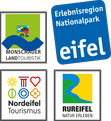LVR-Freilichtmuseum Kommern
Mechernich
History up close at the LVR Open-Air Museum Kommern
Chickens run freely between the houses, cows graze in the meadows, the smell of bread wafts through the air - it could hardly be more idyllic. At the LVR Open-Air Museum Kommern, visitors walk through villages as they once stood in the Rhineland. The Eifel, Lower Rhine, Bergisches Land, Westerwald and Rhineland Marketplace assemblies feature historic buildings from the former Prussian Rhine Province. Farms, windmills, workshops but also communal buildings such as schoolhouses, bakehouses, dance halls and chapels can be explored. How did people live in these villages in past centuries? How did they earn their living? Visitors take a journey through time and look over the shoulders of craftsmen and farmers at their work. The journey begins at the end of the 15th century and leads to the more recent past with Quelle-Fertighaus and Milchbar. The architectural monuments are embedded in a museum landscape with fields, farm gardens and orchards.
Of houses and inhabitants
The house from Kalsbach in the Oberbergisches region, for example, was built in 1667 as a storeyed structure and served a moderately wealthy farming family as a dwelling house, stable and farm building. The windmill from Cantrup dates from 1780 and grain was ground here for many decades. The community house from Löhndorf in the Westerwald served the inhabitants of the village as a bakery and school. Visitors can experience with all their senses how people used to live and work in the Rhineland. Craftsmen give insights into their work: a blacksmith, a mousetrap maker, a wheelwright, a weaver or a beekeeper show how they used to work.
Animals in the museum
Visitors young and old can explore the houses in which people lived at their leisure. And they will meet all kinds of animals on the grounds, because the museum not only wants to show how people lived, but also what they grew in the fields and gardens and what animals belonged on the farm.
Exploring the 20th century
In Kommern, history is being written: The Rhineland Marketplace is dedicated to the second half of the 20th century. Some visitors will recall memories from their childhood and youth, "oh yes, I know this from the old days". Incidentally, the buildings are not replicas, but were dismantled from their original locations and rebuilt in the museum. The Quelle prefabricated house, for example: In the 1960s, it was possible to order houses from the mail-order catalogue. In Kommern, a house from 1965 is on display, with which the Uhlmann couple in the Puhlheim district of Stommelerbusch fulfilled a great dream. Many other buildings on the Rhineland marketplace will evoke memories and children will see how their parents and grandparents lived when they were small.
Exhibitions and markets
In addition to the assemblies with their buildings and inhabitants, the permanent exhibition "WirRheinländer" (We Rhinelanders) invites visitors on a journey through the history of the Rhineland and the living conditions of its people from the French occupation in 1794 to the early years of the economic miracle around 1955. There are also changing special exhibitions. Many events - spread over the whole year - round off the offer in the open-air museum: from workshops for children and adults to festivals and markets lasting several days. The Anno Dazumal fair, for example, takes place annually around Easter time, there are time screens that take visitors back to the time exactly 50 years ago, a harvest festival is celebrated in September and in Advent, "Advent für alle Sinne" gets visitors in the mood for the Christmas season.
The Open Air Museum is open on 365 days of the year. In summer from 9.00a.m. till 7.00p.m, in winter from 10.00a.m. till 5.00p.m.





















